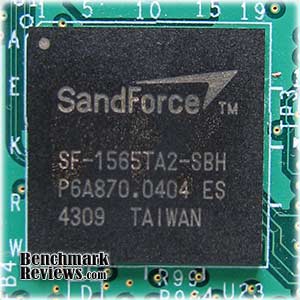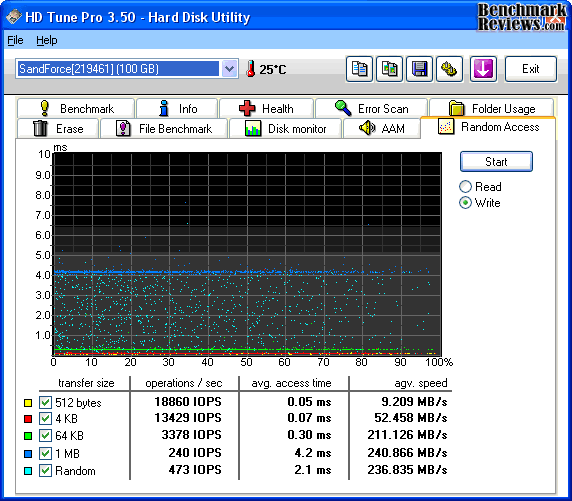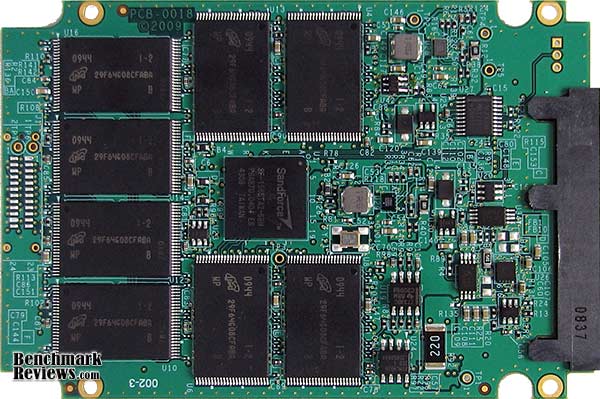| SandForce SF1500 Enterprise SSD Processor |
| Reviews - Featured Reviews: Storage | |||||||||||||||||||||||||
| Written by Olin Coles | |||||||||||||||||||||||||
| Wednesday, 20 January 2010 | |||||||||||||||||||||||||
SandForce SF1500 Solid State DriveSince their retail introduction at the 2008 Consumer Electronics Show, Solid State Drives have been at the center of my attention. In just two short years, the entire SSD market has recreated itself several times over. Counting the generations of SSD processors has become difficult for experienced experts, and keeping-up with architecture has come with its own challenges. Benchmark Reviews has tested dozens of Solid State Drive controllers, and we've seen everything from dual-SATA controllers in RAID-0 to large cache buffer modules. In this article Benchmark Reviews inspects the SandForce SF1500 Solid State Drive architecture, which is used in the (now-cancelled) OCZ Vertex-2 Pro MLC SSD. As of January 2010 several major companies offer Flash NAND SSD controllers. with many more in development. The most popular consumer controllers are: Indilinx IDX110M00-FC "Barefoot", Intel PC29AS21AA0, JMicron JMF612, Samsung S3C29RBB01-YK40, Toshiba T6UG1XBG and Marvell 88SS8014-BHP2. OCZ and others hope to add the SandForce SF-1500 controller onto this list very soon. During the 2010 Consumer Electronics Show, it seemed like manufacturers were desperately racing to be the first company to launch a SandForce-based SSD. Retail leaders have already projected Q1-2010 product availability, and at least one company has already built marketing brochures claiming that they are the first with a SandForce-based SSD product on the market. Fortunately, OCZ is a company that doesn't launch vaporware and waits for samples to be in-hand before issuing a press release. Despite all of the hype, Benchmark Reviews was able to walk away from CES with a working product sample from OCZ... who will probably be the first company to have the SandForce SSD to market... for real.
Our SandForce SF-1500 SSD processor board was taken from the OCZ Vertex-2 Pro SSD engineering sample. The Vertex-2 Pro shares the same SandForce processor and layout as the upcoming Vertex-2 and Vertex-2 Pro EX models, so this article should cover the entire Vertex-2 series; with exception to flash NAND parts which may differ between models. From the top-view image above, it doesn't look like there's anything dramatically innovative on the SandForce Solid State Drive. Eight flash NAND modules make a horseshoe around the SandForce SF-1500 SSD processor, and plenty of electronics fill in the remaining space atop the printed circuit board. Once the SandForce SSD board is turned to expose the underside, the difference is obvious: SandForce has used their DuraClass technology to remove the DRAM buffer and incorporate a flat-capacitor to retain data.
The SandForce SF-1565TA2-SBH processor is part of their SF-1500 family of SSD controller chips, and SSDs will utilize either the SF-1200 processor for retail consumers or SF-1500 for enterprise devices. All SandForce SSD controllers offer native TRIM support in Windows 7. SF-1500 SSD Processors provide superior ECC data protection and include SandForce's unique RAISE (Redundant Array of Independent Silicon Elements) technology. RAISE provides the protection and reliability of RAID on a single SSD drive, thanks to flash architecture, without the significant write overhead of parity. The SandForce DuraClass technology automatically stores data in AES-128 encrypted format, preventing data extraction directly from the physical flash memory modules. 
The brand of internal NAND flash memory used in SSDs is usually a decision left up to the OEM, although our test sample (OCZ Vertex-2 Pro) utilized Micron MT29F64G08CFABAWP IC parts. These lead-free RoHS-compliant 48-pin ICs use multi-layer cell 64Gb density, and require 3.3V per module.
The real twist in SandForce's design is the large Cap-XX HZ202, which is a dual-cell flat capacitor that stores 0.09 farad at 5.5 volts. The extra power reserve is necessary to enable SandForce 'DuraClass' technology, a feature that ensures write commands are completed from the power stored in the super-capacitor included on Enterprise-only products. It's an insurance policy that guarantees data integrity on sudden power loss, and allows the last write does to complete so no data is lost. The Vertex-2 Pro will be the first high-performance enterprise SSD to offer this feature, and will be exclusive to their Enterprise-specific models and not retail enthusiast products.
Another benefit of SandForce's architecture is that the SSD keeps information on the NAND grid and removes the need for a separate cache buffer DRAM module. The result is a faster transaction, albeit at the expense of total storage capacity. The 128GB model measures only 100GB once formatted, with an estimated 20GB dedicated to transaction space. EDITOR'S NOTE: OCZ Technology will not produce the OCZ Vertex-2 Pro as previously planned. They have instead produced the OCZ Vertex-2 Limited Edition.
OCZ Vertex-2 Pro Enterprise SSDThe OCZ Vertex 2 Series is the industry-leading flash-based storage solution, delivering the performance and reliability of SSDs with superior performance across a wider spectrum of consumer and enterprise class applications. The OCZ Vertex 2 Series is the result of all the latest breakthroughs in SSD technology, including the first model on the market to use the SandForce controller. All Vertex Series 2 SSDs come backed a leading three year warranty and OCZ's legendary service and support, giving you added peace of mind for your high performance investment. Additionally, enthusiasts are put at the forefront of cutting edge technology with the available firmware updates and active online SSD community. Perfect for notebooks and desktops alike, the Vertex 2 Series is ideal for energy-efficient mobile computing to extend battery life, increase the speed of access time, and provide a durable alternative to conventional hard disc drives with superior shock resistance. High capacities and low power consuming NAND flash technology provide the necessary performance and battery life boosts generated by the proliferation of mobile gaming and new ultrathin laptops. The OCZ Vertex 2 drives feature a durable yet lightweight alloy housing, and because OCZ SSDs have no moving parts, the drives are more rugged than traditional hard drives. Designed for ultimate reliability, Vertex Series SSDs have an excellent 1.5 million hour mean time before failure (MTBF) ensuring reliability over the long term.
|
|||||||||||||||||||||||||
|
DuraClass Technology: |
- DuraWrite extends the endurance of SSDs - Intelligent Block Management & Wear Leveling - Intelligent Read Disturb Management - Intelligent "Recycling" for advanced free space management - RAISE (Redundant Array of Independent Silicon Elements) - Best-in-Class ECC protection for longest data retention and drive life |
|
Host Interface: |
- SATA 2.6 Compliant, 3Gb/s and 1.5Gb/s support - Native Command Queuing (up to 32 commands) - SMART Command Transport |
|
Max Capacity Supported: |
512GB as of Q1 2010 |
|
Performance (sustained): |
- Sequential Read & Write Transfer: 260MB/s (@128K blocks) - Random Read & Write IOPS: 30,000 (@4K blocks) |
|
Flash Memory Support: |
MLC & SLC from major vendors |
|
Power Consumption: |
- Typical: 950mW - Sleep/Slumber: 50mW |
|
Security: |
- Data Encryption: 128-bit AES-compliant - User Selectable Encryption Key |
|
Protection: |
- ECC Recovery: Up to 24 bytes correctable per 512-byte sector - Unrecoverable Read Errors: Less than 1 sector per 1017 bits read |
|
Reliability: |
- MTTF: 10,000,000 operating hours - Supports 5-year enterprise life cycle |
|
Operating Temperature: |
0°C to 70°C ambient |
|
Package: |
361-Pin TFBGA - 13x13mm, 0.65mm pitch |
|
Compliance: |
RoHS, Halogen-Free, Green |
OCZ Preliminary Specifications*
-
Max Read 280
-
Max Write 270
-
4K Random Write (QD=8): 19,500 IOps
-
128K Sequential Write (QD=32): 260MBps
* OCZ Has not yet finalized their product specifications for the SandForce-based Solid State Drives.
Vertex-2 Key Benefits
-
Superior bandwidth performance
-
Enhanced reliability with MLC flash
-
Delivers best in class reliability
-
SandForce controller makes MLC flash viable for enterprise applications
-
Improved IOPS over competing solutions
In the next section, Benchmark Reviews reveals some initial performance test results using the OCZ Vertex-2 Pro SSD...
SandForce SF-1500 Performance
The ATTO Disk Benchmark 2.34 program measures interface transfer rates at various intervals for a user-specified length and then reports read and write speeds for these spot-tests. ATTO Disk Benchmark requires that an active partition be set on the drive being tested, and for testing purposes we format using NTFS after SSD partition alignment. The charted results illustrate bandwidth speed using various file size chunks, and can be used as a general performance indicator.

HD Tune is a low-level test that will not operate on a drive which contains a partition, so Benchmark Reviews uses DISKPART to prepare hardware and remove any partitions before conducting these tests. Random Access tests are divided into 512b, 4KB, 64KB, 1MB and random size test files sizes. The Random Access test measures the performance of random read or write operations. The amount of data which will be read varies from 512 bytes to 1 MB. Performance is reported in operations per second (IOPS), average access time, and average speed. Because it is our intent to compare one product against another, Benchmark Reviews has focused on random transfer size IOPS performance.

Using the OCZ Toolbox utility to format a +1 alignment to the drive, ATTO reported a maximum read-speed of 250 MBps and a respectable 263 MBps write performance. For operational input/output, HD Tune reports 16,355 IOPS for 4KB reads and 13,429 IOPS for write-to operations. Because of the impressive I/O performance, the SandForce SF1500 SSD processor is best suited for high-transaction enterprise environments.

In the coming months, Benchmark Reviews will test several new Solid State Drive products based on SandForce SSD processors. Our entire collection of SSD articles is available in the Benchmark Reviews Featured Reviews: Storage section.
Questions? Comments? Benchmark Reviews really wants your feedback. We invite you to leave your remarks in our Discussion Forum.
Related Articles:
- Tagan CS-Monolith Mid Tower ATX Case
- LEVEL8 Products Macbook Air Sleeve
- ASUS P7P55D EVO P55 LGA1156 Motherboard
- ASRock Core-100HT Intel i3-330M HTPC
- ASUS P6T Deluxe OC Palm Edition X58 Motherboard
- Corsair P64 CMFSSD-64GBG2D RAID-0 Set
- Patriot PC3-15000 DDR3 1866MHz 2GB RAM Kit
- ASUS EAH4890 TOP Radeon HD 4890 RV790
- Gigabyte HD5870 SOC Video Card GV-R587SO-1GD
- SilverStone Raven SST-RVM01B Gaming Mouse








Comments
Have to say that standard SSD/HDD tests can not correctly test SandForce-based SSDs.
The main reason is in the nature of the SandForce chip - it is not only RAID 5 - like controller, it is also a data compression engine.
So, any testing data stream (ually a small repeated data pattern) dous not test a drive, but only a compression engine productivity.
This results in very high throughput and IOPS.
To test the drive itself, the data stream should be virtually uncompressible - think this will give quite another results.
Also, database read pattern (reading random parts af a huge file) will not be that fast even on highly compessible data.
So, the good test of this drive should provide benchmarks on both - highly comressible and virtually uncomressible data, giving the possible productivity range in the real live.
You are just wrong lol,
mabye the benchmarks are misleading however you need to consider the way these controllers work, indilinx has a huge write amplification (x10) where as SANDFORCE have a write amplification of x1.1 meaning the MLC NAND on a SANFORCE controller will last much longer than any indilinx controlled SSD. I own both indilinx and sandforce based SSD's and sandforce performance is much better. Have a read on the sandforce website, they have a fact and fiction section, its very interesting!
On highly compressible data it will by definition outperform any other drive, but in other applications it might lag way behind, and the tests show nothing on this side. We may only guess what is a compression impact on the internal drive productivity.